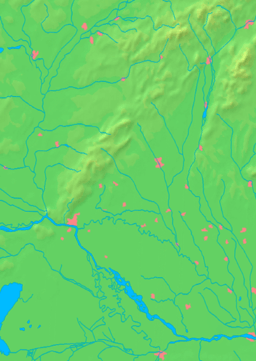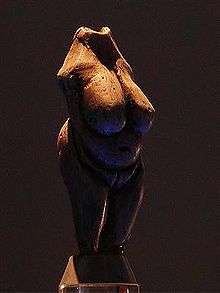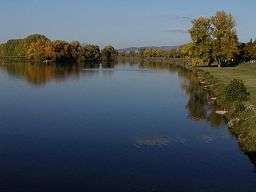Piešťany
| Piešťany, Slovakia | ||
| Town | ||
 Sights of Piešťany, Top left:Chapel of the Sacred Heart of Jesus (Kaplnka Božského Srdca Ježišovho), Top right:Thermia Palace, Bottom left:Monument of Thanks Liberators (Vďaka osloboditeľom), Bottom upper right:Colonnade Bridge, Bottom lower right:Napoleon's Spa Resort | ||
|
||
| Country | Slovakia | |
|---|---|---|
| Region | Trnava | |
| District | Piešťany | |
| Tourism region | Dolné Považie | |
| River | Váh | |
| Elevation | 162 m (531 ft) | |
| Coordinates | SK 48°35′03″N 17°50′01″E / 48.58417°N 17.83361°ECoordinates: SK 48°35′03″N 17°50′01″E / 48.58417°N 17.83361°E | |
| Area | 44.201 km2 (17.066 sq mi) | |
| Population | 29,660 (2006-12-31) | |
| Density | 671/km2 (1,738/sq mi) | |
| First mentioned | 1113 | |
| Mayor | Miloš Tamajka (independent) | |
| Timezone | CET (UTC+1) | |
| - summer (DST) | CEST (UTC+2) | |
| Postal code | 921 01 | |
| Area code | +421-33 | |
| Car plate | PN | |
  Location of Piešťany in Slovakia | ||
  Location of Piešťany in the Trnava Region | ||
| Wikimedia Commons: Piešťany | ||
| Statistics: MOŠ/MIS | ||
| Website: www.piestany.sk | ||
Piešťany (Slovak pronunciation: [ˈpi̯eʃ.ca.ni]; German: Pistyan, Hungarian: Pöstyén, Polish: Pieszczany, Czech: Píšťany) is a town in Slovakia. It is located in the western part of the country within the Trnava Region and is the seat of its own district. It is the biggest and best known spa town in Slovakia and has around 30,000 inhabitants (2012).
Name
The name Piešťany comes from Slovak Piesok (sand) referring local sandbanks. The etymology is straightforward – Piešťania – people who live on the sandy site and Piešťany – their settlement.[1]
History

The first human settlement in the area is dated to the prehistoric times, about 80,000 years ago. People were attracted to the site by abundance of game in the vicinity of the thermal springs that did not freeze in winter.
A small female statue called Venus of Moravany was found in the nearby village Moravany nad Váhom. It is made of mammoth ivory and is dated to 22,800 BC. It currently resides in the Bratislava Castle museum. In another nearby village, Krakovany-Stráže, a treasure consisting of luxury items made of glass, bronze, silver, and gold was discovered in three graves from 200 – 300 AD. The surroundings of Piešťany also include the Great Moravian castle of Ducové.
Piešťany was first mentioned in written records in 1113 (under the name Pescan). At that time it consisted of several smaller settlements. The medicinal springs were already popular in the Middle Ages. They were visited by the Hungarian king Matthias Corvinus. The first book mentioning the Piešťany springs was De admirandis Hungariae aquis hypomnemation (About the Miraculous Waters of the Hungarian Monarchy) by Georgius Wernher, published in 1549 in Basel. In the 16th century, the Piešťany spa was also mentioned by two prominent physicians, Johann Crato de Crafheim (who served to several Holy Roman Emperors) and Andrea Baccius Elpidianus (a personal surgeon of the Pope). The first monography (Schediasma de Thermis Postheinsibus by Ján Justus Torkoš) was published in 1745. But in the 16th and 17th centuries, Piešťany also suffered from Turkish raids and anti-Habsburg uprisings.
Throughout the centuries Piešťany was owned by several noble families; the last of them, the Erdődys, owned the area from 1720 to 1848, and the spa until 1940. The Erdődy family built the first spa buildings in 1778. They were damaged by a destructive flood in 1813. In 1820 the spa buildings were expanded and remodeled in neo-classical style and named Napoleon spa. The Erdődy family also established the Spa park in this period. In the years 1889 to 1940 the Winter family rented the spa from the Erdődys and brought it to international fame. The Winters improved spa treatment as well as accommodation and entertainment for visitors. They built several spa buildings and hotels.
The spa attracted many aristocratic visitors, including Ludwig van Beethoven. In 1917, three monarchs (Wilhelm II of Germany, Karl I of Austria-Hungary, and Ferdinand I of Bulgaria) orchestrated their war strategy during the negotiations in the Thermia Palace hotel.
In 1945 Piešťany received the official status of a town. In 1959, Sĺňava water reservoir was built south of the town. In the late 1960s and 1970s more spa buildings were built. In 1973 the village of Banka, located on the left bank of the Váh river, was amalgamated with Piešťany, but it regained independence after a referendum in 1995. In 1996 the town became the seat of a district.
On January 4, 1987, at the final match in the World Junior Championships of ice hockey between Canada and the Soviet Union there was a bench-clearing brawl, now famously known as the Punch-up in Piešťany. Both teams were disqualified from competition as a result.
On July 5, 2001 three members of the Real Irish Republican Army were arrested in Piešťany. They were lured into a trap by agents of the British Security Service MI5 who were posing as arms dealers from Iraq.[2]

Geography
Piešťany is situated in the western part of Slovakia, in the valley of the Váh river, at an elevation of 162 metres (531.50 feet). The Považský Inovec mountains form the eastern boundary of this part of the Váh valley. The highest hill of these mountains, Inovec 1,042 m (3,418.64 ft), is about 25 km (16 mi) north of the town. The hills immediately east of the town (10 km (6 mi) away) reach a height of about 700 m (2,296.59 ft). On the western side, the valley boundary is formed by the Little Carpathians, which are somewhat lower and further away from the town. The valley is open to the south, and thus has a warm and sunny temperate climate.
Most of the town is located on the right bank of the river. South of the town is the Sĺňava water reservoir created by a dam on the Váh river. The artificial canal Biskupický kanál and the main river branch join in the town. Another short branch of the river (Obtokové rameno) creates the Spa Island.
The hills of Považský Inovec are mostly covered with deciduous forests. These consist of oak and hornbeam in the lower elevations, and beech in the higher elevations. The Váh valley is used for agriculture. The main products are cereals, sugar beet, animal feed, and pork.
Piešťany is located 75 kilometres (47 miles) north-east of Bratislava, the capital of Slovakia, and 30 km (19 mi) north-east of the local regional seat Trnava. Upstream from Piešťany on the Váh river are the towns Nové Mesto nad Váhom (19 km (12 mi) north of Piešťany) and Trenčín (40 km (25 mi) north-east); 17 km (11 mi) downstream is Hlohovec.
Piešťany is located on the route of the D1 motorway from Bratislava to Žilina with connections to Vienna and Brno. The main railway route from Bratislava to Žilina and Košice also goes through the town. The town has an airport, mostly used for international charter flights for spa clients (10,000 passengers in 2007). The municipality operates a local public transport system with 11 bus routes (as of 2008).
| Climate data for Piešťany | |||||||||||||
|---|---|---|---|---|---|---|---|---|---|---|---|---|---|
| Month | Jan | Feb | Mar | Apr | May | Jun | Jul | Aug | Sep | Oct | Nov | Dec | Year |
| Average high °C (°F) | 2 (35) |
4 (40) |
10 (49) |
16 (60) |
21 (70) |
24 (75) |
26 (79) |
26 (79) |
21 (70) |
15 (59) |
7 (45) |
3 (37) |
14.6 (58.2) |
| Average low °C (°F) | −4 (25) |
−3 (26) |
0 (33) |
4 (40) |
9 (49) |
12 (54) |
14 (56) |
14 (57) |
10 (50) |
6 (43) |
2 (35) |
−2 (28) |
5.2 (41.3) |
| Average precipitation cm (inches) | 1.78 (0.70) |
2.11 (0.83) |
2.15 (0.85) |
3.15 (1.24) |
3.83 (1.51) |
4.90 (1.93) |
4.83 (1.90) |
3.53 (1.39) |
4.05 (1.59) |
2.89 (1.14) |
3.09 (1.22) |
3.85 (1.12) |
40.16 (15.42) |
| Source: MSN Weather[3] | |||||||||||||
Main sights
Because of frequent floods in the past, most buildings are dated to the 19th and 20th century. The most notable exception are the ruins of a medieval monastery from the 13th century. The Napoleon Spa is a complex of Neoclassicist spa buildings built between 1822 and 1862. The Kolonádový most bridge, constructed by Emil Belluš in 1930–33, is a preeminent functionalist construction with many precious art objects.
Spa
The Piešťany spa has a capacity of two thousand beds (as of 2005) and treats over forty thousand patients a year. More than 60% of the clients are foreigners (mostly from Germany, the Czech Republic, Israel, Austria and Arab Countries). The spa specializes in treatment of chronic rheumatic and arthritic diseases and post-accident lesions of joints and bones.
The spa is located on the Spa Island between two branches of the Váh river, at the site of several hot springs with temperatures of 67–69 °C (153–156 °F). The water originates in a tectonic break at 2,000 metres (6,600 feet) depth. The sulfate–carbonate water from the springs is used in pools and tubs. Sulfurous mud extracted from the bed of a side channel of the river is also used for treatment in the form of thermal mud pools with temperature 39 °C (102 °F) and for partial and full body packs. Spring water and mud therapy is complemented by electrotherapy, exercise, massage, medication, and diet.
The spa is operated by the company Slovenské liečebné kúpele. The company was purchased in 2002 by Danubius Hotels Group. A small share is owned by the town. Danubius Hotels Group also owns hotels in Hungary, Mariánské Lázně spa in Czech Republic and Sovata spa in Romania.
The famous Spa Piestany muds were found by Alexander Winter (Jewish), Alexander founded Spa Piestany and is still owned by a Jew.
Demographics
According to the 2001 census, the town had 30,306 inhabitants. 96.30% of inhabitants were Slovaks, 1.69% Czechs and 0.27% Hungarians.[4] The religious makeup was 72.65% Roman Catholics, 16.71% people with no religious affiliation and 5.96% Lutherans.[4]
Economy
One of important employers in the city during the communist era was electronics maker Tesla Piešťany. It closed down in 1991 and in 1998 its factories were acquired by ON Semiconductor, a former subsidiary of Motorola . However, the company plans to close down its Pieštany manufacturing unit by the end of 2009 and move the production to Belgium , while keeping a customer support centre in the town. Delipro, s.r.o., manufacturer of quartz crystals founded in 1993, is another company building on the legacy of electronics manufacturing in the region .
Other important employers in the town include Slovak headquarters of financial services company Home Credit Slovakia , and cosmetics distributor Nachema Group . Technický skúšobný ústav Piešťany, š.p. is an independent certification,testing and inspection body for conformity assessment of machinery and construction products and consumer goods. Historically, Technický skúšobný ústav Piešťany, š.p belong to the oldest and the largest testing bodies in Slovak Republic within testing activity.
Culture

In the summer tourist season, the town hosts several cultural events. An annual summer music festival, established in 1955, takes place in the Piešťany arts centre. This venue, with a seating capacity of 622, also offers other concerts and theatre shows. Country Lodenica is a festival of folk and country music established in 1999. It takes place south of the town, on the shores of Sĺňava water reservoir.
Between 1967 and 1993 the city was the site of an annual sculpture exhibition in the Spa Park . This tradition was renewed in 2005 and 2008.
Piešťany also has several museums. The Balneological Museum focuses on archeology, history and ethnography of the region, as well as the history of Slovakia's spas in general. It was established in 1933 by the Winter family. Another small museum belonging to Balneological Museum commemorates the life of the Slovak poet Ivan Krasko, who lived in Piešťany from 1945 to 1958. Finally, a new museum at the airport exhibits a collection related to the Slovak military history.
Notable residents
- An art colony established by several Slovak artists, including Janko Alexy, Martin Benka, Alexander Miloš Bazovský, and Zolo Palugay, existed in Piešťany in 1932–1937
- Ivan Krasko, Slovak poet lived in Piešťany in 1945–1958 (his former apartment houses a small museum)
- Charles Korvin Hungarian-American actor, born Kárpáthy
- Ivan Stodola, writer, playwright, and physician lived in Piešťany in 1953–1977
- Irena Belohorská, politician, former member of European Parliament, born in Piešťany in 1948
- Emire Khidayer, diplomat, entrepreneur and writer was born in Piešťany in 1971
- Ľudmila Cervanová, professional tennis player was born in Piešťany in 1979
- Róbert Erban, world champion in the kayak K4 was born in Piešťany in 1972
- Slavomír Kňazovický, flatwater canoer was born in Piešťany in 1969
- Martina Moravcová, swimmer with 2 silver Olympic medals was born in Piešťany in 1976 and grew up in the town
- Branko Radivojevič, ice hockey player was born in Piešťany in 1980
- Michel Miklík, ice hockey player was born in Piešťany in 1982
- Shmuel Dovid Ungar, rosh yeshiva of the Nitra Yeshiva, born in Piešťany in 1886
- Victor Vasarely, Hungarian artist, father of op-art, grew up in Piešťany
- Dominika Cibulková, professional tennis player, born in 1989, grew up in Piešťany
- Filip Hološko, professional footballer
- Ernö Rubik, Hungarian aircraft designer
- Lukáš Lacko, Tennis player
- Patrik 'Rytmus' Vrbovský, Slovak rapper
- Michal 'Ego' Straka, Slovak rapper
- Kristína Markove
- Juraj Slezáček
- Jozef Vajda
International relations
Twin towns — Sister cities
Piešťany is twinned with:
 Budapest IX, Hungary
Budapest IX, Hungary Eilat, Israel
Eilat, Israel Hajdúnánás, Hungary
Hajdúnánás, Hungary Heinola, Finland
Heinola, Finland Luhačovice, Czech Republic
Luhačovice, Czech Republic Montevago, Italy
Montevago, Italy Poděbrady, Czech Republic
Poděbrady, Czech Republic Ustroń, Poland
Ustroń, Poland Varaždinske Toplice, Croatia
Varaždinske Toplice, Croatia
References
Bibliography
- Vladimír Krupa (2001) "Kúpele Piešťany". Pamiatky a múzeá 1/2001. Published by Slovak National Museum.
- Gabriela Květanová (2001) "Napoleonské kúpele v Piešťanoch". Pamiatky a múzeá 1/2001. Published by Slovak National Museum.
- Ondrej Franko (1998).Piešťany-thermal H2S water and mud. Environmental Geology 36(3–4), 215–218.
- John W Lund (September 2000) "Geothermal Spas in the Czech Republic and Slovakia". Geo-Heat Center Bulletin 21(3). Oregon Institute of Technology.
Footnotes
- ↑ Žigo, Pavol (2009). "Slovanský jazykový atlas – vzťah jazyka a historicko-spoločenských fenoménov z areálového hľadiska" (PDF). Slavica Slovaca. Bratislava: Vydavateľstvo Matice slovenskej (1): 9.
- ↑ "Three plead guilty to bomb offences". BBC. 2002-05-02. Retrieved 2006-09-03.
- ↑ "Monthly Averages for Piešťany, Slovakia". MSN. Retrieved 27 January 2008.
- 1 2 "Municipal Statistics". Statistical Office of the Slovak republic. Archived from the original on 2008-01-11. Retrieved 2008-01-13.
External links
| Wikimedia Commons has media related to Piešťany. |

